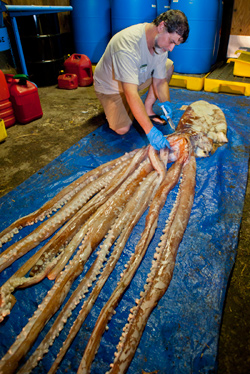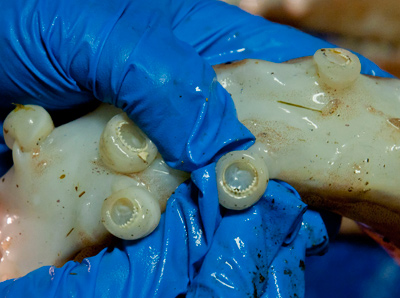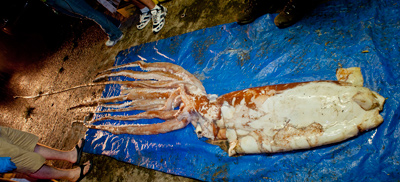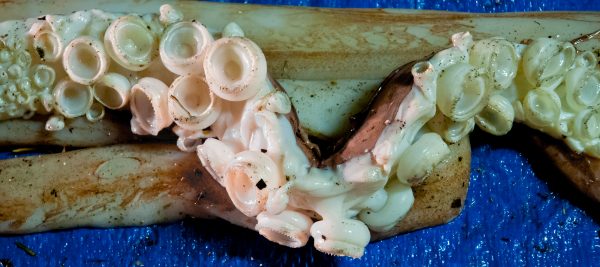
Florida Museum photo by Jeff Gage
One of the mysterious legends of the sea, the giant squid has haunted sailors for hundreds of years. From the adventures of Homer’s Odysseus to Melville’s Ishmael, the unknown of the deep invokes fear that the creatures may even threaten ships.
In 1830, Alfred, Lord Tennyson depicted the fabled sea monster “The Kraken,” as “far beneath the abysmal sea,” and “with giant arms.” In the final lines of the poem, he wrote, “Then once by man and angels to be seen, In roaring he shall rise and on the surface die.”
It was this image that caught the attention of three recreational fishermen about 12 miles offshore from Jensen Beach Sunday, June 26, 2011. They spotted a 25-foot-long giant squid dying near the surface at about 11 a.m. and decided to slide it into the back of their 23-foot-boat so the sighting would not be lost as legend.
“I thought we definitely need to bring it in, because no one’s going to believe us if we don’t,” said Robert Benz, who was fishing with friends Joey Asaro and Paul Peroulakis. “I didn’t want to leave it out there and just let the sharks eat it.”
The next day, Museum researchers collected the deep-water specimen from the Florida Fish and Wildlife Conservation Commission Tequesta Field Laboratory in Palm Beach County. The specimen is the only one of its kind in the collections of the Florida Museum of Natural History on the UF campus.

Florida Museum photo by Jeff Gage
“It’s so rare to get these specimens and they’re such deep-water animals that we don’t know much about how they live,” said John Slapcinsky, Florida Museum malacology collection manager. “This specimen provides an excellent opportunity to learn things about these creatures we couldn’t find out any other way.”
Giant squid only reproduce once in their lifetime, and then often die slowly, after becoming lethargic, Slapcinsky said. The animal was likely in that state when the fishermen found it, he believes, because it was barely alive and near the surface in 170 feet of water.
Giant squid are one of the largest invertebrates, growing up to 60 feet long and weighing more than 1,000 pounds, but because they are seldom seen, little is known about their reproduction, ecology and life span. Depicted as sea monsters throughout history, squid are normally deep-water dwellers and some are known to spar with sperm whales, a common predator, Slapcinsky said.

Florida Museum photo by Jeff Gage
“This is a pretty massive animal,” he said. “It took about six people to move it, and it wasn’t light.”
The animal is white with red skin containing chromatophores, or color-bearing cells. Squid can activate these pigment cells, rapidly changing their color and color intensity for communication and in some species camouflage, Slapcinsky said.
The specimen is from the same genus as the giant squid depicted in the Florida Museum’s 2006 temporary exhibit, “In Search of Giant Squid.” The exhibit produced by the Smithsonian Institution focused on the fact the creature had never been witnessed alive in its natural habitat – a feat later accomplished by a Japanese film crew.
Florida Fish and Wildlife Conservation Commission scientists extracted genetic samples from the squid, which were brought with the specimen to UF. Scientists injected formalin into the body cavity before submerging the squid in a 10 percent solution of the preservative.

Florida Museum photo by Jeff Gage
“It looks nice, it’s still in fabulous shape and it’s big,” Slapcinsky said. “It would be really cool to exhibit something like this, if it turns out that it preserves well enough and we can find a way to exhibit it so that it doesn’t damage the specimen.”
The specimen is still undergoing the preservation process that will enable researchers to further examine the squid to determine its sex and age and compare it with other specimens. Scientists hope to gain a greater understanding of the life of these elusive creatures, including their range, diet and how they reproduce.
The genetic data will be of particular interest to researchers trying to determine if there are one or more species of giant squid, said Museum invertebrate paleontologist Roger Portell.
“We don’t really have a good handle on the biogeography of these critters, so this will add to that knowledge base,” Portell said. “Because they are so rare, we have so few samples where we get a fresh specimen and can actually do genetic work.”
Learn more about the Invertebrate Zoology at the Florida Museum.